- LAGRANGIAN
- Posts
- Issue 74 | Breaking Space News: Oct 26 - Nov 01, 2025
Issue 74 | Breaking Space News: Oct 26 - Nov 01, 2025
Earth is on the Brink as Pace of Climate Change Outstrips Mitigation Efforts. This Week in Space News: Behold the Eye of Melissa and the Red Spider Nebula. First 3D Exoplanet Atmosphere Map, 3I/ATLAS Updates and the End of Human Activity at Venus. Plus: SpaceX and Cards Against Humanity Settle Trespassing Lawsuit, and More.
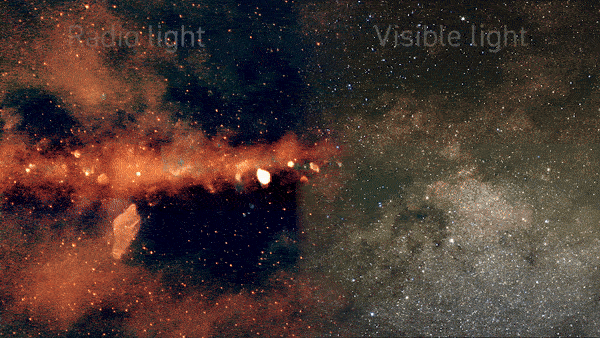
Thanks for joining, Explorer🚀
While global tensions continue to shape headlines, the steady advance of scientific research offers progress that persists beyond the immediacy of conflict. The commercial space sector had some notable movements. Also don’t miss some breathtaking images. Click the link below to read the unclipped publication. ↓
Let’s jump in.
Scientists Create First 3D Map of Exoplanet Atmosphere Using James Webb Data
JAXA’s Akatsuki Goes Silent After Nearly a Decade Studying Venus’s Atmosphere
New Climate Report Shows Earth on the Brink as Pace of Climate Change Outstrips Mitigation Efforts
Interstellar Comet 3I/ATLAS Shows Unusual Luminosity Surge as It Passes Near the Sun
Iridium Unveils Global PNT Chip to Protect Devices from GPS Spoofing and Jamming
New Space Startup Besxar Signs SpaceX Launch Deal to Test Orbital Semiconductor Manufacturing
UK Joins Global Push for Independent Orbital Monitoring with Slingshot Deal
Modular Satellites, SDA Payloads, and Space-Based Broadband Mark Global Investment Shift
MTN’s New Enterprise Satellite Service Built on Starlink LEO Network Offers Secure Satellite Links
Momentus and DPhi Space Partner to Launch Edge Computing Payload on Vigoride Mission
Ukraine’s Kyivstar Begins Nationwide Trials of Starlink Satellite-to-Phone Technology

IMAGES
The Eye of Hurricane Melissa : Copernicus Sentinel 2
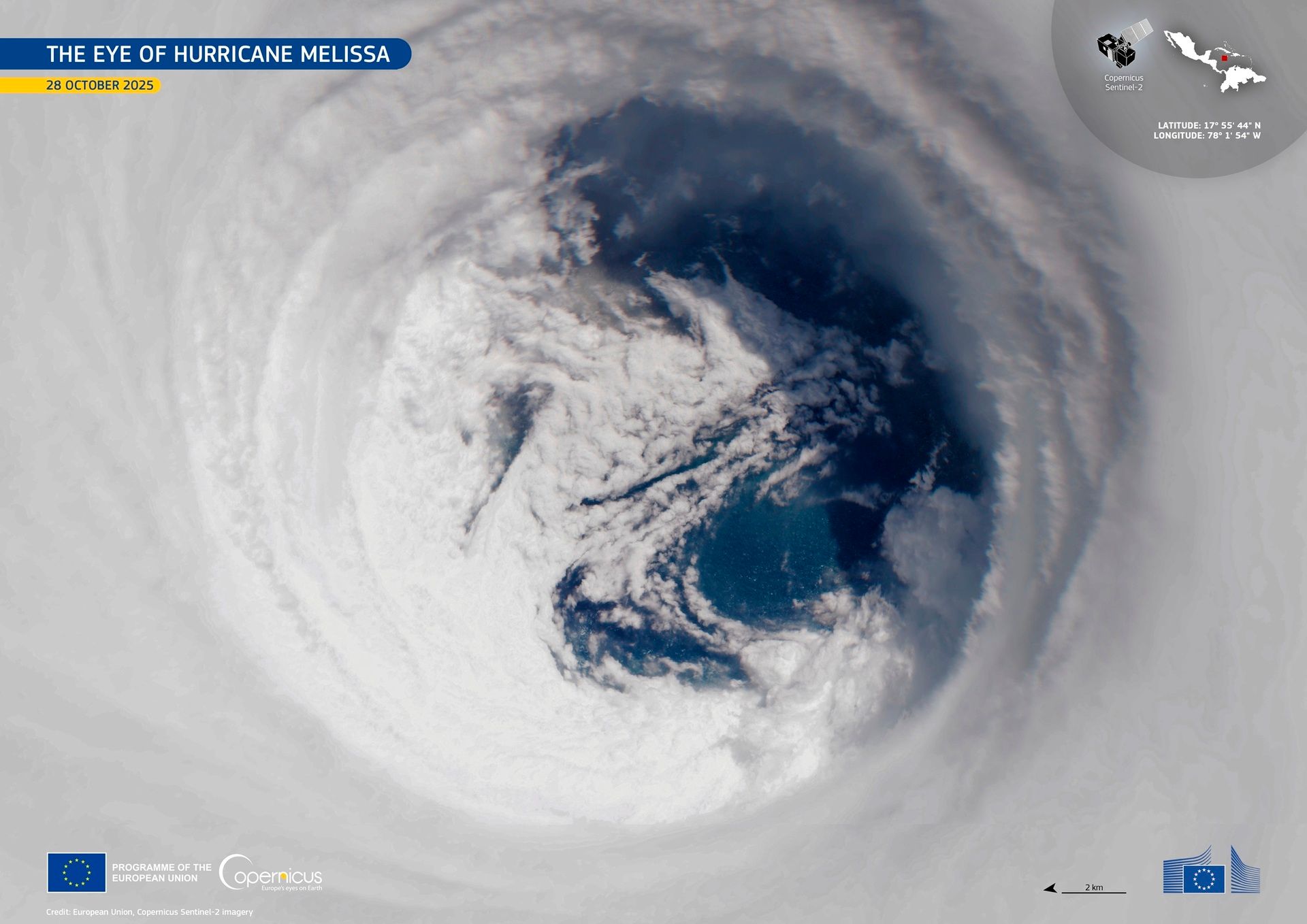
On 28 October 2025 at 15:55 UTC, the Copernicus Sentinel-2 satellite captured a striking image of Hurricane Melissa’s eye just hours before landfall on Jamaica’s southern coast. With sustained winds of 298 km/h and a central pressure of 892 hPa, Melissa became the most powerful storm in the island’s history and one of the most intense hurricanes ever recorded in the Atlantic basin. (Credit: European Union, Copernicus Sentinel Imagery)
Red Spider Nebula : James Webb Space Telescope
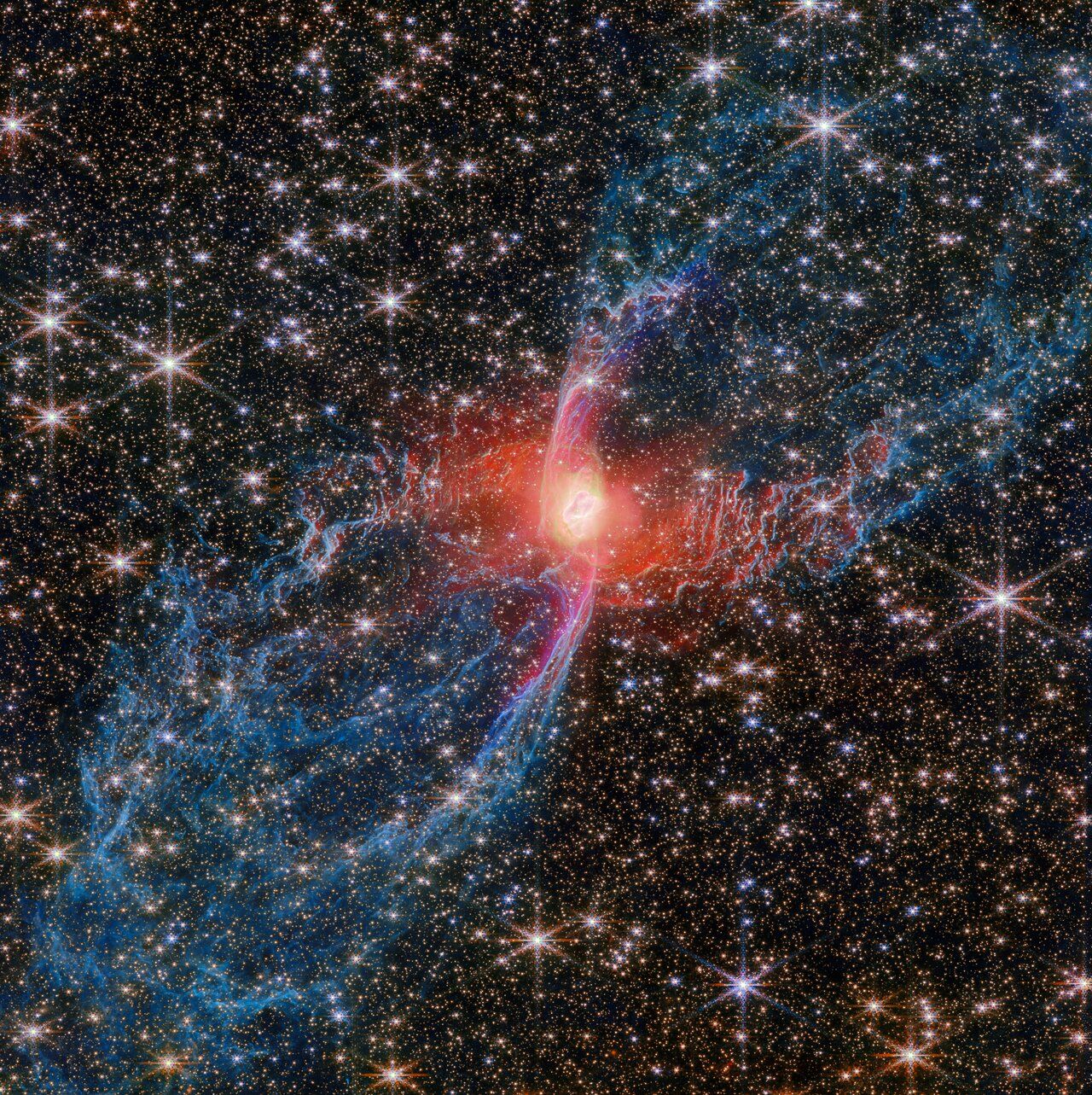
The James Webb Space Telescope has captured unprecedented details of NGC 6537, known as the Red Spider Nebula, revealing new insights into planetary nebula formation and stellar evolution.
Using its Near-Infrared Camera (NIRCam), Webb imaged the nebula’s central star, previously faint in optical wavelengths, as a red source surrounded by hot dust, possibly in a disc. The image shows massive, closed lobes extending 3 light-years, traced by molecular hydrogen, and a fast-moving jet marked by ionized iron forming an elongated S-shape. These features suggest dynamic outflows and hint at a hidden companion star shaping the nebula’s hourglass structure. (Credit: ESA/Webb, NASA & CSA, J. H. Kastner (Rochester Institute of Technology))
RCW 94, 95 Nebulae in Visible and Infrared : VLT Survey Telescope, VISTA
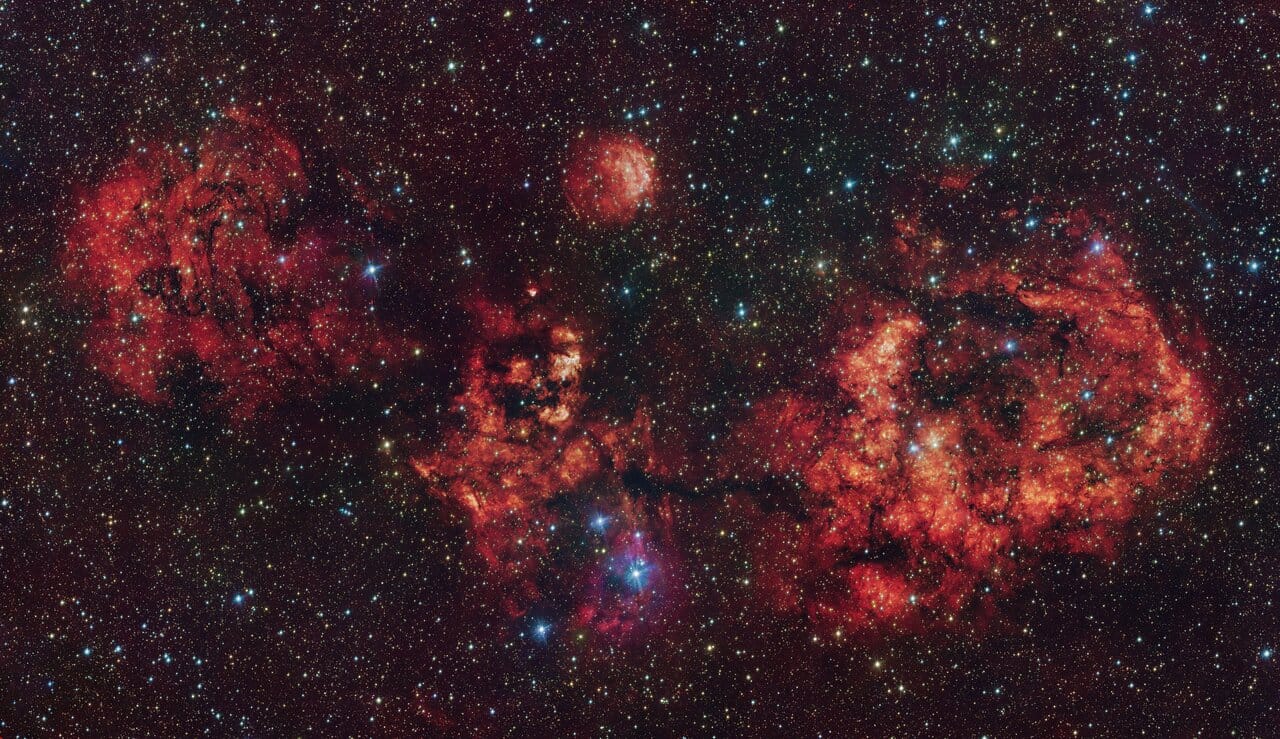
ESO’s Paranal Observatory has released a composite image of RCW 94 and RCW 95, two H II regions in the Milky Way, revealing a vast emission nebula shaped like a bat—dubbed the “Cosmic Bat” for its Halloween-timed release.
Captured using the VLT Survey Telescope and ESO’s Visible and Infrared Survey Telescope for Astronomy (VISTA), the image combines visible and infrared data to show hydrogen gas ionized by young stars. RCW 94 forms the bat’s right wing, while RCW 95 outlines its body. The structure highlights active star formation and the complex interplay of radiation and dust. Astronomers note the image’s value in tracing stellar feedback and nebular morphology. (Credit: ESO/VPHAS+ team/VVV team)
Southern Hemisphere View of Our Milky Way Galaxy : International Centre of Radio Astronomy Research (ICRAR)

The GLEAM/GLEAM-X view of the Milky Way galaxy along with the same area of the Milky Way in visible light.
Compiled by ICRAR using data from the GLEAM and GLEAM-X surveys, the image spans 1 million CPU hours and 141 nights of observation with the Murchison Widefield Array in Western Australia. It reveals 98,000 radio sources, including supernova remnants, pulsars, and star-forming regions. The map’s enhanced resolution and sensitivity allow researchers to distinguish between gas from newborn stars and remnants of stellar death, advancing efforts to trace the life cycles of stars and map galactic feedback. (Credit: S. Mantovanini & the GLEAM-X team; Axel Mellinger)

SCIENCE
China’s Shenzhou 21 Crew Begins Six-Month Stay at the Tiangong Space Station as Gaofen-14 Joins Earth Observation Constellation
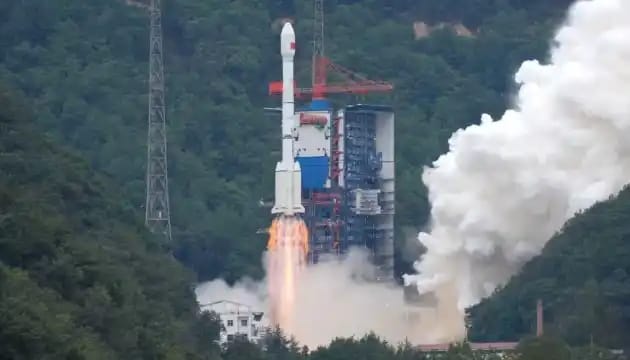
China launched the Gaofen-14-02 Earth observation satellite aboard a Long March-4B rocket from Xichang Launch Center, targeting economic and defense applications. (Credit: CCTV)
26 October, 2025
China has carried out two launches this week, one crewed, one remote sensing.
China launched the Gaofen-14-02 Earth observation satellite, reportedly serving both economic and defense purposes. The satellite joins the Gaofen constellation, which supports applications ranging from resource mapping to strategic surveillance. While official details remain limited, the launch aligns with China’s ongoing investment in dual-use space infrastructure.
The Gaofen-14 02 satellite was launched aboard a Changzheng-4B (Long March-4B) rocket from the Xichang Satellite Launch Center in Sichuan province, located in southwestern China. According to its developers, the satellite is designed to provide high-resolution stereo imagery worldwide and support geospatial applications tied to economic planning and national defense.
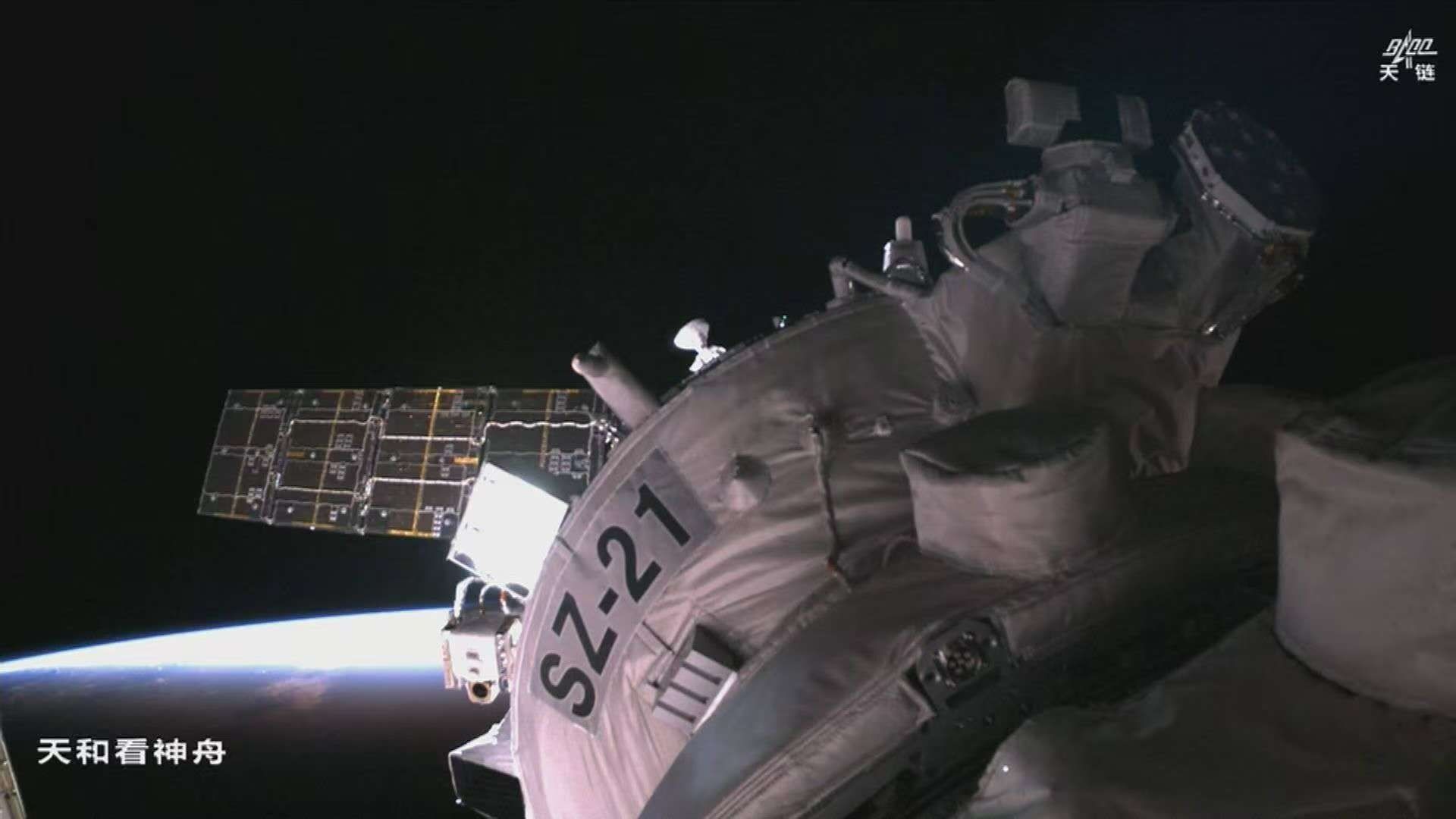
Shenzhou-21 seen docked with the Tiangong space station on October 31, 2025. (Credit: CMSEO)
31 October, 2025
In parallel, on October 31, China launched the Shenzhou 21 mission to its Tiangong space station, achieving docking in just 3.5 hours—a national record. The three-person crew includes veteran astronaut Zhang Lu and two first-time flyers: engineer Wu Fei, China’s youngest astronaut at 32, and payload specialist Zhang Hongzhang. Over a six-month stay, the crew will conduct 27 experiments in biotechnology, aerospace medicine, and materials science. Notably, four mice were sent aboard for short-term behavioral studies, marking China’s first live animal research in orbit.
The Tiangong station, built and operated solely by China, has become a platform for both domestic research and international collaboration, with plans underway to train and host Pakistani astronauts.
Scientists Create First 3D Map of Exoplanet Atmosphere Using James Webb Data
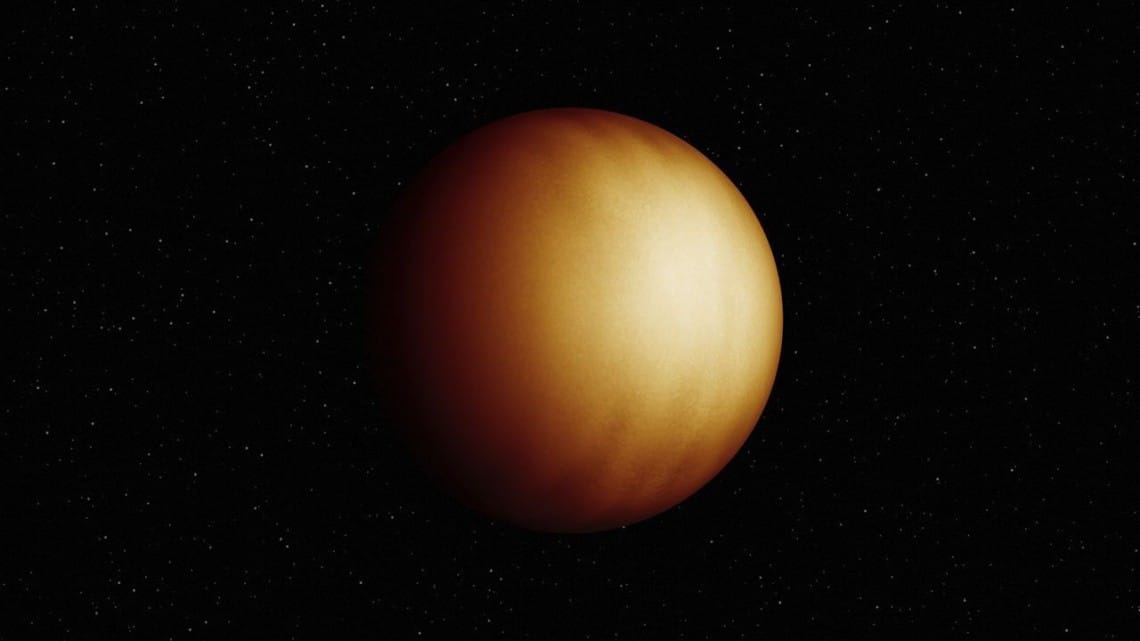
WASP-18b, a gas giant classified as an ultra-hot Jupiter due to its extreme temperatures. (Credit: NASA/JPL-Caltech (K. Miller/IPAC))
28 October, 2025
Astronomers have produced the first three-dimensional map of an exoplanet’s atmosphere, revealing extreme thermal and chemical dynamics on WASP-18b, a gas giant 400 light-years from Earth.
Using data from NASA’s James Webb Space Telescope (JWST), researchers applied a technique called spectroscopic eclipse mapping/3D eclipse mapping to reconstruct temperature variations across the planet’s latitude, longitude, and altitude. WASP-18b, classified as an “ultra-hot Jupiter,” orbits its star in just 23 hours and reaches temperatures near 5,000°F/2760°C. The map revealed a central hotspot on the planet’s dayside, surrounded by cooler limb regions. Notably, water vapor appears to break down in the hottest zone, a phenomenon predicted by theory but now confirmed through direct observation.
The study, co-led by Cornell and University of Maryland scientists, marks a shift from 2D to 3D atmospheric modeling and opens the door to similar analyses of other hot Jupiters. Researchers say the method could help characterize hundreds of exoplanets already identified by JWST.
JAXA’s Akatsuki Goes Silent After Nearly a Decade Studying Venus’s Atmosphere
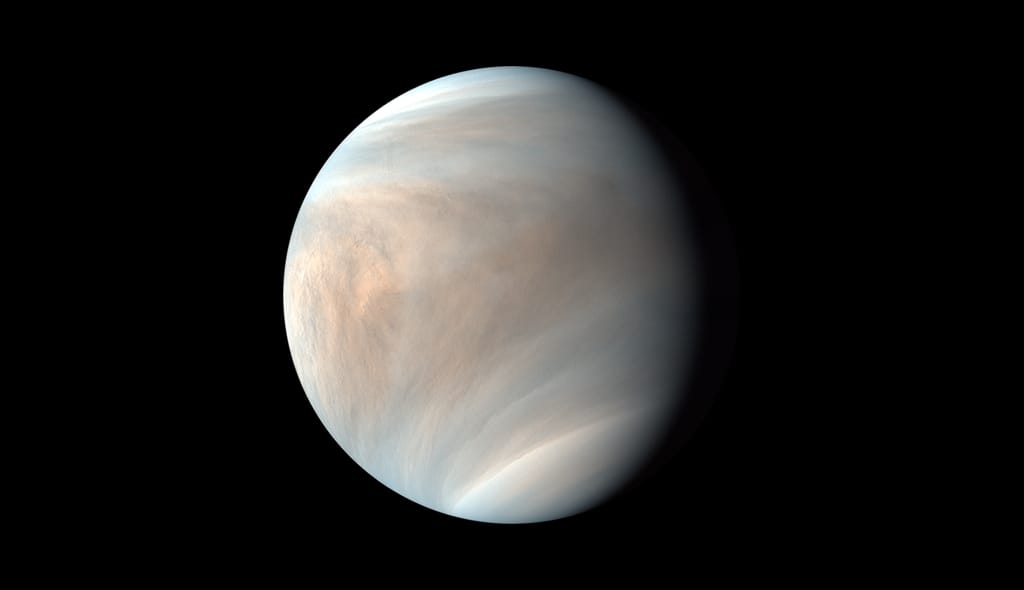
Ultraviolet image of Venus’s dayside taken by Akatsuki’s UVI instrument, shown in false color using 283 nm and 365 nm wavelength data. (Credit: PLANET-C Project Team)
28 October, 2025
Japan’s Akatsuki orbiter has officially gone silent, ending humanity’s active presence at Venus and closing a chapter in planetary climate research. Launched in 2010 by JAXA, Akatsuki overcame a failed orbital insertion and re-entered Venus orbit in 2015 using backup thrusters, a maneuver never before attempted. Designed to study Venus’s atmosphere, the spacecraft revealed key insights into the planet’s super-rotating winds, gravity waves, and cloud dynamics. Its ultraviolet and infrared imaging helped explain how solar heating sustains high-speed winds despite Venus’s slow rotation, offering parallels to atmospheric behavior on tidally locked exoplanets.
After losing contact in May 2024, JAXA spent over a year attempting to reestablish communications before formally terminating the mission in September 2025. Akatsuki was the only active spacecraft at Venus for nearly a decade. With its departure, future exploration now hinges on upcoming missions from NASA and ESA, including DAVINCI, VERITAS, and EnVision, each targeting Venus’s atmosphere, surface, and interior.
New Climate Report Shows Earth on the Brink as Pace of Climate Change Outstrips Mitigation Efforts
29 October, 2025
A new report published in BioScience confirms that 2024 was likely the hottest year in at least 125,000 years. Researchers from Oregon State University and other institutions found that 22 of 34 planetary “vital signs,” including ocean heat, glacier loss, and greenhouse gas concentrations, are now at record extremes. The authors describe Earth as “on the brink,” with climate-driven disruptions threatening ecosystems, public health, and global governance.
The report draws on satellite data, paleoclimate records, and IPCC benchmarks, emphasizing that the pace of change is outstripping mitigation efforts. While the authors stress that recovery is still possible, they call for urgent systemic action to avoid cascading tipping points. The findings, like numerous other reports reiterate the need for coordinated planetary stewardship, as space-based Earth observation becomes increasingly vital for monitoring and response.
Interstellar Comet 3I/ATLAS Shows Unusual Luminosity Surge as It Passes Near the Sun
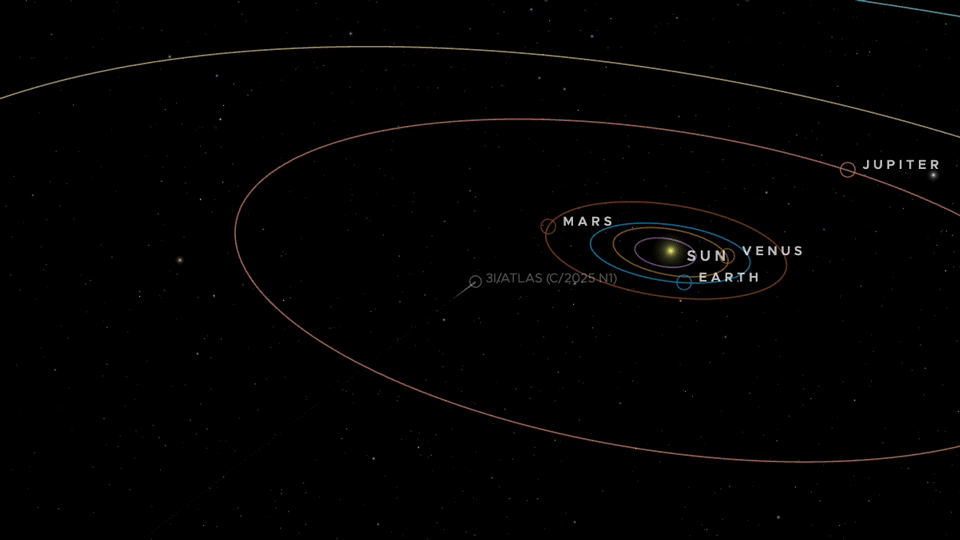
Animation of comet 3I/ATLAS's trajectory through our solar system. (Credit: NASA/JPL)
30 October, 2025
Comet 3I/ATLAS, the third known interstellar object to enter our solar system, has baffled scientists with an unexpected and rapid brightening as it neared the Sun in late October 2025.
Unlike typical Oort cloud comets, 3I/ATLAS exhibited a surge in luminosity far exceeding predictions, prompting speculation about its internal composition and behavior. The comet’s perihelion, its closest approach to the Sun, was monitored using space-based instruments including NASA’s STEREO spacecraft, SOHO, and NOAA’s GOES-19 satellite, as Earth-based observations were obstructed by solar glare. Researchers noted that the brightening may be linked to volatile materials reacting to solar heating, but the precise mechanism remains unclear.
This anomaly adds to the intrigue surrounding interstellar visitors, following ‘Oumuamua in 2017 and 2I/Borisov in 2019. Scientists hope that continued monitoring of 3I/ATLAS will yield insights into the chemical environments of distant planetary systems and refine models of cometary evolution beyond our solar neighborhood. Scientists Qicheng Zhang of Lowell Observatory and Karl Battams of the U.S. Naval Research Laboratory published their findings on the arXiv research repository.

GOVERNANCE
EU Proposes Formal Talks to Integrate Ukraine into Secure Satellite Communications and Space Monitoring System
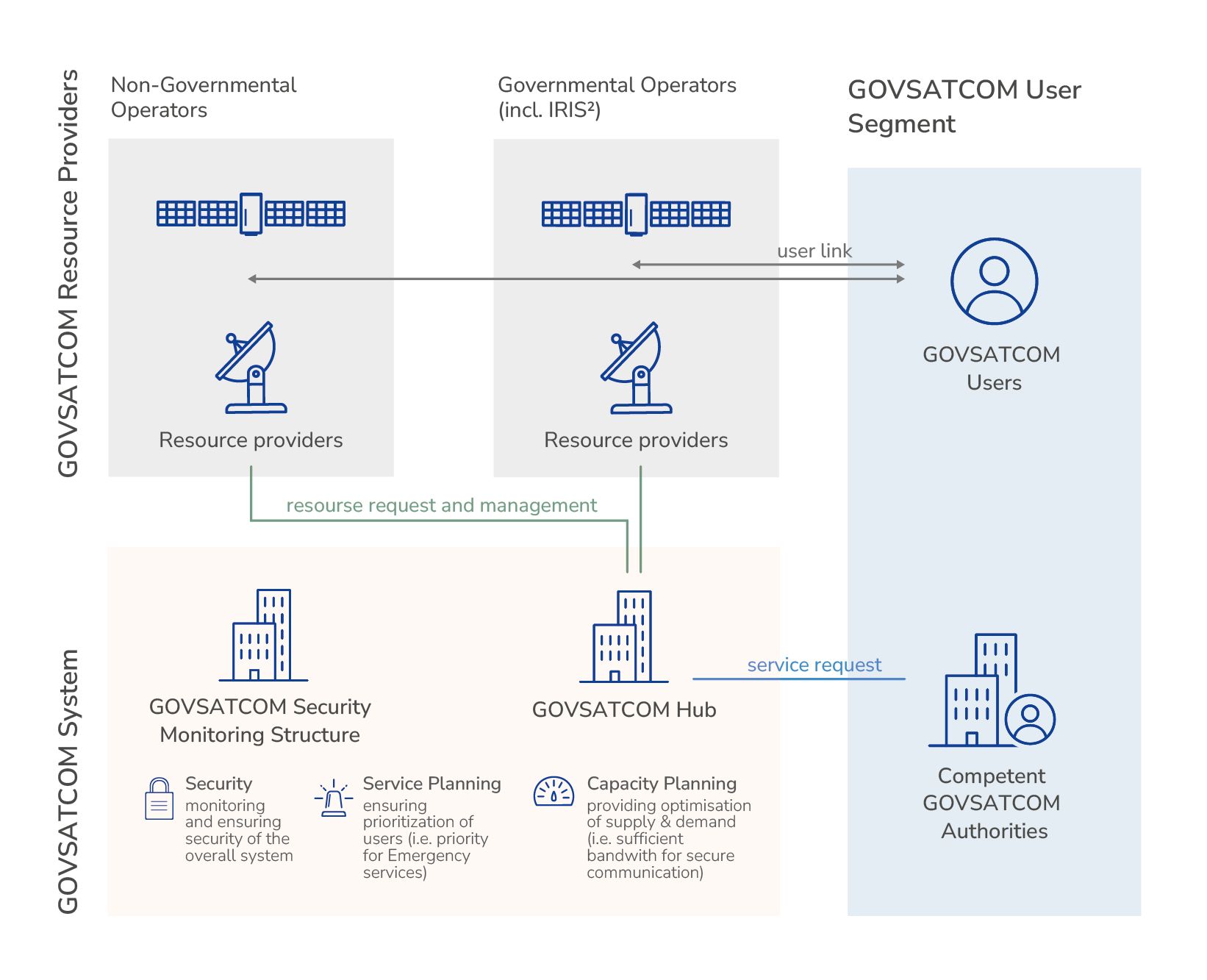
Diagram of the GOVSATCOM system showing how satellite resources are managed and prioritized for secure governmental communications across Europe. (Credit: EU Space Programme)
27 October, 2025
The European Commission has proposed opening formal negotiations to integrate Ukraine into the EU’s secure satellite communications architecture. The initiative would allow Ukraine to participate in the Governmental Satellite Communications (GOVSATCOM) component of the EU Space Programme, which pools resources from member states and private operators to provide secure, resilient connectivity for government and crisis-response missions. This follows Ukraine’s April 2025 agreement to join other EU space segments, including Copernicus, Space Weather, and Near-Earth Object monitoring.
Commission Vice-President Henna Virkkunen emphasized that deeper space collaboration enhances shared security and technological sovereignty. The move also aligns with broader EU efforts to deploy IRIS², a sovereign satellite infrastructure slated for 2030, and to support Ukraine through instruments like SAFE (Security Action for Europe). If approved by the Council, the negotiations would formalize Ukraine’s role in Europe’s evolving space and defense ecosystem.
SpaceX Settles $15 Million Trespassing Lawsuit with Cards Against Humanity Over South Texas Land Near Starbase

Cards Against Humanity owned land near SpaceX’s Starbase facility in South Texas, in 2017. (Credit: Cards Against Humanity)
27 October, 2025
SpaceX has settled a $15 million trespassing lawsuit filed by Cards Against Humanity over disputed land use near its Starbase facility in South Texas. The conflict began in 2024 when the game company alleged that SpaceX had stored construction equipment and debris on a plot of land it purchased in 2017 to protest former President Trump’s proposed border wall. The land, located along the Rio Grande, was crowdfunded through 150,000 donations and intended to remain undeveloped. Cards Against Humanity claimed SpaceX treated the property as its own for at least six months, prompting legal action in Cameron County District Court.
The upside is that SpaceX has removed their construction equipment from our land and we're able to work with a local landscaping company to restore the land to its natural state: devoid of space garbage and pointless border walls.

Construction equipment and materials, in 2024, located on the South Texas land owned by Cards Against Humanity. (Credit: Cards Against Humanity)
The case was resolved in October 2025 before a scheduled jury trial, though the settlement terms remain undisclosed. The company stated it was barred from further comment but confirmed SpaceX vacated the site. The incident highlights growing tensions between private space expansion and local land stewardship near launch zones.
FCC Proposes Assembly Line Licensing Framework to Modernize Satellite and Earth-Station Approvals
28 October, 2025
The U.S. FCC has launched a sweeping rulemaking to modernize satellite and earth-station licensing, aiming to streamline approvals and support the growing space economy. Announced during the agency’s designated “Space Month,” the proposal introduces a modular “licensing assembly line” under a new Part 100 framework, replacing legacy Part 25 rules. The system is designed to accelerate application reviews, increase predictability, and reduce regulatory burdens for commercial operators. Key changes include simplified license modifications, a nationwide earth-station license, and light-touch safety measures requiring satellite operators to share space situational awareness data.
Chairman Brendan Carr emphasized a shift from a “default to no” to a “default to yes” regulatory mindset, promoting permissionless innovation. The Satellite Industry Association has endorsed the overhaul, citing its potential to expedite licensing and improve spectrum utilization. The FCC also plans to open 20,000 MHz for satellite broadband and continue clearing application backlogs to maintain U.S. competitiveness.

MILITARY
Australian Firm, HEO, Uses Satellite-to-Satellite Imaging to Model and Reveals New Details of Chinese Technology Test Spacecraft
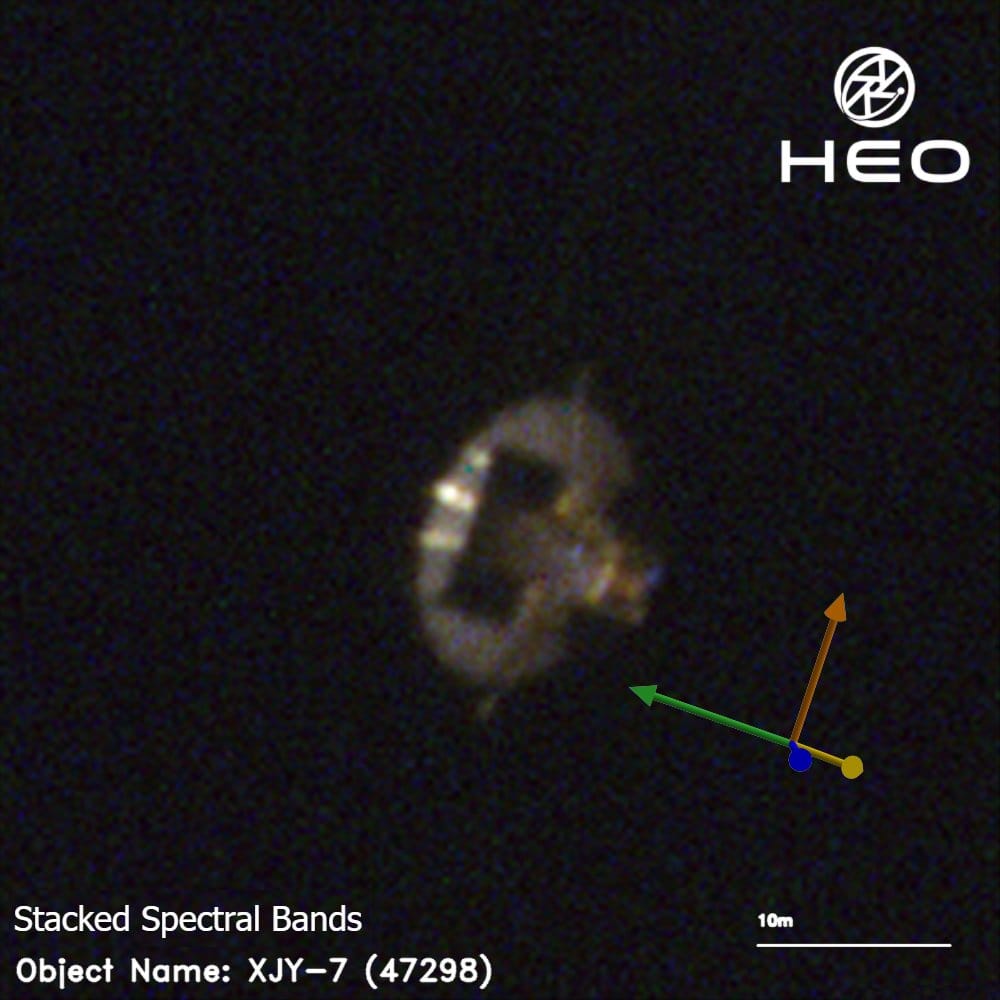
HEO used high-frequency orbital imaging to model China’s XJY-7 satellite, revealing SAR capabilities and full-body rotation for solar charging, details previously inferred from a single render. (Credit: HEO)
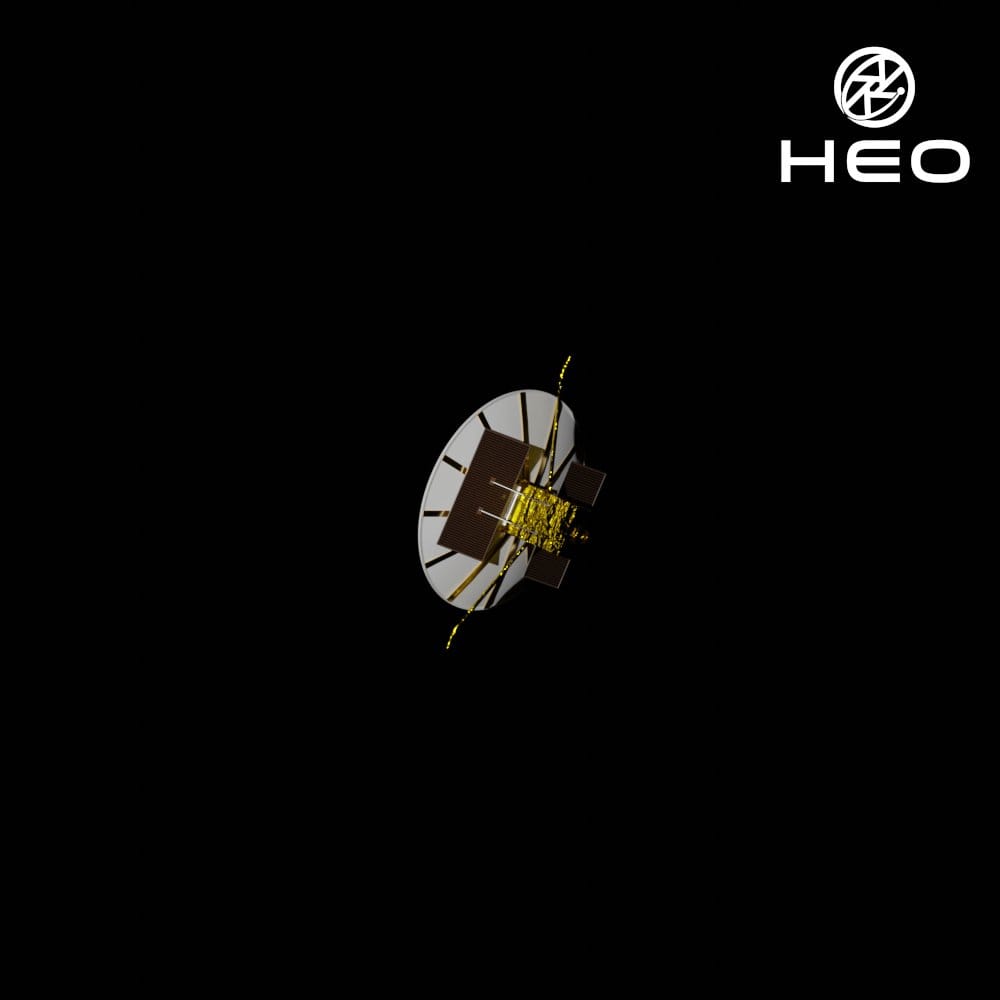
Credit: HEO
27 October, 2025
Australian non-Earth imaging company, HEO has released detailed imagery and a 3D model of China’s Xinjishu Yanzheng-7 (XJY-7) satellite, shedding light on a previously opaque technology test mission.
Launched in December 2020 aboard the debut Long March 8 flight, XJY-7 was officially described as a remote sensing verification satellite developed by the China Academy of Space Technology. However, HEO’s non-Earth imaging (NEI) operations revealed a synthetic aperture radar (SAR) antenna and a large radar dish, suggesting advanced surveillance capabilities. The satellite’s fixed solar arrays required full-body rotation for power generation, a behavior confirmed through simultaneous imaging by HEO’s partner satellites.
The case highlights NEI’s growing role in Space Domain Awareness (SDA), offering insights beyond conventional ground-based tracking. In the emerging geopolitical dynamics, Chinese and Western firms are increasingly imaging each other’s spacecraft. XJY-7 reportedly reentered Earth’s atmosphere over the Canary Islands on October 16, 2025.
Known for high-resolution images of the ISS and Tiangong station, HEO uses NEI via hosted payloads to capture spacecraft from orbit. Its latest initiative, dubbed “solar system on demand,” envisions imaging distant targets like asteroids and interplanetary probes. The company’s Holmes Mk2 camera, designed for fly-by NEI, enables scalable monitoring from sub-10 km to hundreds of kilometers. HEO’s expansion of orbital imaging capabilities introduces new transparency into a domain traditionally shaped by national security constraints.
US Military to Expand ‘Government-Owned Commercially-Operated’ Satellite Strategy Amid Rising Conflict Risk
30 October, 2025
The U.S. Space Force is expanding its use of the GOCO (government-owned, commercially-operated) model to balance national security needs with commercial innovation, amid what the U.S. considers rising geopolitical threats to space infrastructure.
Prompted by concerns over wartime targeting of commercial satellites, highlighted by Russia’s warnings about Western assets aiding Ukraine, the Pentagon is shifting toward owning critical satellites while outsourcing operations to private firms. Speaking at the MilSat Symposium on October 29, industry executives and defense officials discussed how programs like MILNET, operated by SpaceX, and initiatives such as MGEO and PTS-G follow this approach, aiming to ensure rapid deployment and resilience in contested environments.
While GOCO arrangements reduce industry exposure to wartime losses, companies remain wary of unclear indemnification under the Commercial Augmentation Space Reserve (CASR) framework. Cybersecurity and geographic vulnerabilities also weigh heavily on operators like Atlas Space Operations. Meanwhile, tensions persist over dual-use procurement, as government demands often push commercial systems into costly custom builds. Still, firms like Astranis see progress, demonstrating military compatibility without hardware changes, pointing to a potential shift toward more pragmatic acquisition strategies.

COMMERCIAL
Iridium Unveils Global PNT Chip to Protect Devices from GPS Spoofing and Jamming

Iridium PNT ASIC. (Credit: Iridium)
27 October, 2025
Iridium Communications has introduced a miniature chip designed to protect GPS-reliant devices from spoofing, jamming, and timing disruptions. The new miniature application-specific integrated circuit (ASIC) Iridium PNT ASIC delivers pole-to-pole positioning, navigation, and timing (PNT) data independent of traditional GNSS systems. At 8×8 mm, the chip is engineered for integration into consumer electronics, industrial systems, and critical infrastructure, including power grids and telecom networks.
Iridium claims this is the first globally available hardware-based solution for authenticated PNT, offering an alternative to software-only defenses. The launch follows a rise in GNSS interference incidents, including recent disruptions to maritime operations near Qatar and a jamming event affecting the European Commission President’s aircraft. The company’s global satellite network enables real-time authentication, positioning the ASIC as a potential standard for next-generation navigation resilience.
Voyager Acquisition of ExoTerra Targets Scalable Propulsion Solutions for US National Security and Commercial Use
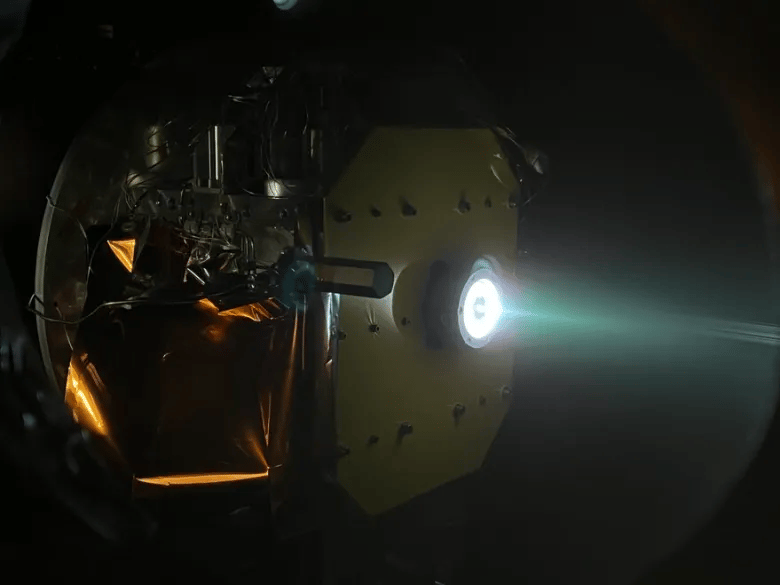
ExoTerra Hall-effect thruster. (Credit: Voyager Technologies)
27 October, 2025
Voyager Technologies has acquired ExoTerra Resource, a U.S.-based developer of electric propulsion systems, in a move to strengthen domestic capabilities for satellite maneuvering and mission resilience. ExoTerra specializes in Hall-effect thrusters and solar electric propulsion modules, with flight heritage that includes DARPA’s Blackjack ACES program and deliveries to York Space Systems for the Space Development Agency’s Transport Layer.
The acquisition is positioned to support both commercial and defense applications, including national security initiatives like Golden Dome. Voyager emphasized the strategic importance of building and qualifying propulsion systems within the U.S., citing the need for precise maneuvering, extended satellite lifetimes, and high-efficiency delta-V performance. The deal comes in the wake of a wider industry move toward scalable, flight-proven propulsion technologies as satellite operators prioritize orbital mobility and threat avoidance. Terms of the acquisition were not disclosed, but Voyager framed the move as closing a critical capability gap in American space infrastructure.
New Space Startup Besxar Signs SpaceX Launch Deal to Test Orbital Semiconductor Manufacturing

Credit: Besxar
28 October, 2025
Besxar Space Industries has emerged from stealth with a launch agreement to test orbital semiconductor manufacturing aboard SpaceX rockets. Founded in 2023 by Ashley Pilipiszyn, Besxar aims to leverage the ultra-high vacuum of space to produce next-generation semiconductor wafers optimized for AI data centers and other high-demand applications. The company’s “Fabships,” which are reusable, microwave-sized manufacturing pods, will fly aboard 12 upcoming Falcon 9 missions, with 24 units scheduled for deployment. These spacecraft are designed to integrate with the booster stage, conduct manufacturing in orbit, and return for reuse.
Besxar claims this approach could reduce contamination and cost compared to Earth-based fabrication. Orbital manufacturing has been garnering a lot of interest as a response to terrestrial limitations in chip production, especially for extreme-performance environments. Initial flights will focus on validating Fabship resilience and process integrity, with plans to scale via longer missions, larger payloads, or increased launch cadence. Besxar’s model remains launch-vehicle agnostic, positioning it for broader integration across commercial platforms.
UK Joins Global Push for Independent Orbital Monitoring with Slingshot Deal
28 October, 2025
Slingshot Aerospace has partnered with the UK Space Agency to deploy its first ground-based optical sensors outside the U.S., marking a shift in how nations approach orbital surveillance.
The agreement will see Slingshot install sensors across the UK and British Overseas Territories, enhancing the UK’s ability to independently verify orbital positions and potential collision risks. The move is part of the UK’s broader effort to build sovereign space domain awareness (SDA) capabilities amid growing orbital congestion and geopolitical uncertainty. Slingshot’s sensors will feed into its Seradata platform, offering real-time tracking and predictive analytics.
This is the company’s first international sensor sale and reflects a wider trend where there’s growing international concern over space traffic management and governments are increasingly seeking independent tracking infrastructure rather than relying solely on U.S. military data.
Countries are increasingly seeking autonomy in space situational awareness as satellite constellations proliferate and geopolitical tensions rise. While the UK’s investment is modest compared to U.S. or Chinese capabilities, it signals a strategic intent to participate more actively in shaping norms around orbital safety and data transparency. However, as commercial actors like Slingshot scale up, the line between public and private space surveillance continues to blur, raising questions about data governance, and the role of industry in shaping global norms in space.
Modular Satellites, SDA Payloads, and Space-Based Broadband Mark Global Investment Shift
Orbital infrastructure and satellite intelligence saw new developments this week with investments in AST SpaceMobile, Bulgaria's EnduroSat, and China's StarDetect.
29 October, 2025
AST SpaceMobile and Saudi telecom operator stc Group have signed a 10-year agreement to deliver space-based cellular broadband across the Middle East, Africa, and parts of Asia. AST SpaceMobile’s first major regional partnership, the deal includes a long-term revenue commitment and aims to extend mobile coverage. 4G and 5G to underserved regions using AST’s BlueWalker satellites, which are designed to connect directly to standard mobile phones without ground infrastructure. STC has committed $175 million in prepayments and will integrate AST’s satellite network with its terrestrial infrastructure. Infrastructure plans include three ground gateways and a network operations center in Riyadh, with commercial service expected to begin in late 2026 pending regulatory approvals. With growing interest in hybrid terrestrial–space telecom models, the partnership builds on earlier technical demonstrations.
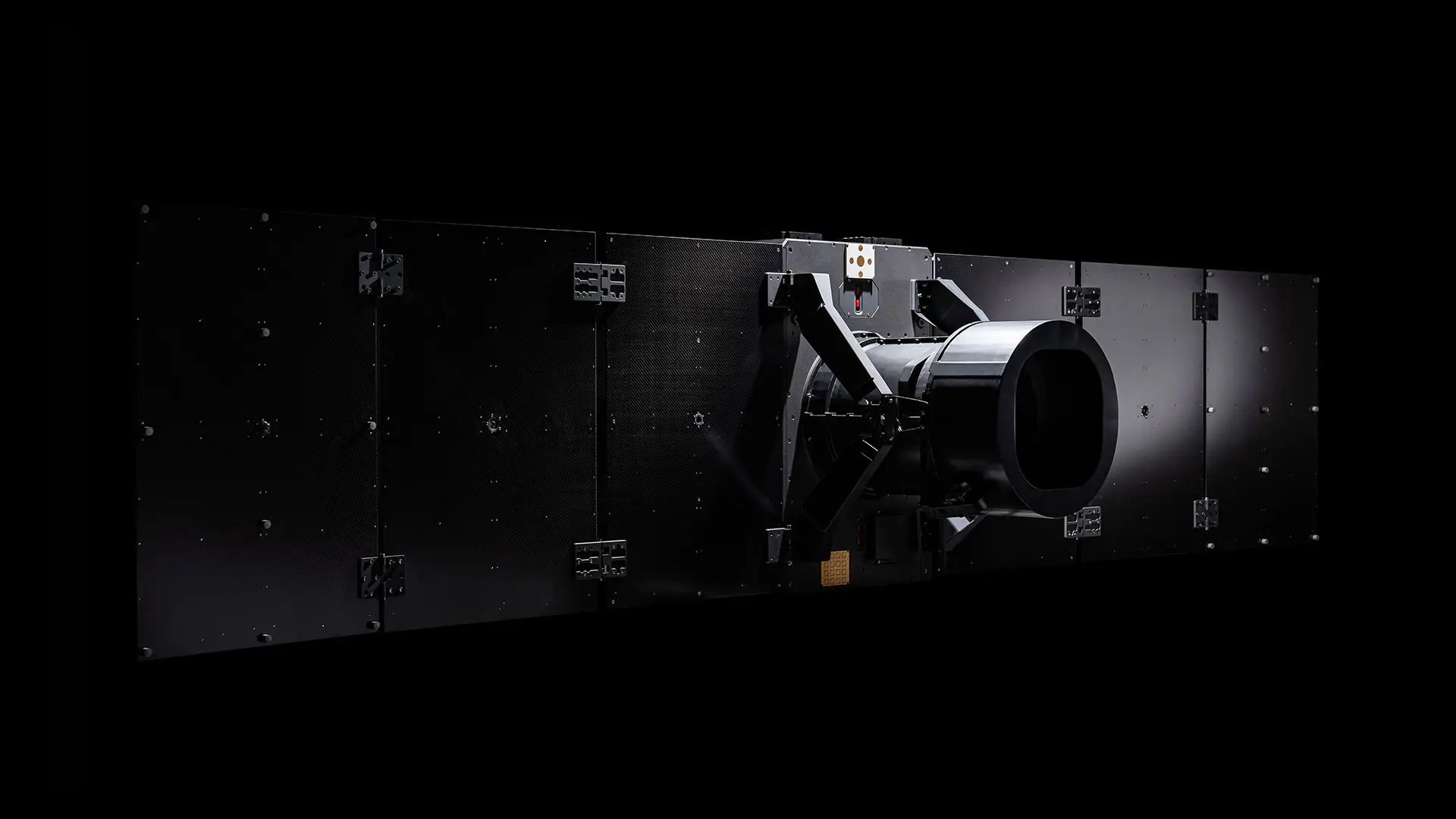
Credit: EnduroSat
30 October, 2025
In Europe, Bulgaria’s EnduroSat raised $104 million in Series B funding led by Google Ventures, with participation from European Investment Fund and existing investors. The company specializes in modular satellite platforms and software-defined payloads, enabling flexible mission architectures for commercial and scientific users. The new funding is expected to scale production of its ESPA-class modular satellites, and is in line with trending investor confidence in smallsat manufacturing for commercial constellations. The company has also expanded operations to Colorado, France, and Germany and plans to deepen its U.S. presence.
The round follows a $50 million raise earlier this year and will support expansion of EnduroSat’s manufacturing capacity, including a new facility in Sofia capable of producing up to two 200–500 kg satellites per day.
Meanwhile, China’s StarDetect secured over 100 million yuan/$13 million in Series A funding to advance low-cost, intelligent payloads for space domain awareness (SDA) and real-time onboard processing. Its event camera technology which is capable of detecting microsecond-level changes in brightness, offers an alternative to traditional frame-based imaging, allowing for efficient tracking of fast-moving or faint objects in orbit. StarDetect’s focus on edge computing and AI-driven SDA will help in China’s push for orbital autonomy amid limited global ground sensor access. The firm’s emphasis on payload-level innovation contrasts with constellation-scale approaches from larger Chinese players like Geovis Insighter.
The rounds were led by Yicun Capital and several state-backed or local government investors, including Wuxi Innovation Investment Group and Jiangyin-based funds.
MTN’s New Enterprise Satellite Service Built on Starlink LEO Network Offers Secure Satellite Links
30 October, 2025
MTN has launched StarEdge Horizon, a Layer 2 enterprise connectivity service built on SpaceX’s Starlink network, offering private satellite links for remote operations without relying on the public internet. The system routes data from Starlink terminals through MTN’s leased terrestrial backbone, bypassing conventional VPN tunnels to reduce latency and simplify network management. Currently available in the U.S. and Europe, StarEdge Horizon targets energy, construction, and logistics sectors, with expansion planned for Latin America, Africa, and maritime use by March 2026.
The service integrates with OneWeb, LTE, and 5G for redundancy and includes direct cloud access to AWS, Azure, and Google Cloud. Meanwhile, SpaceX continues to expand Starlink’s enterprise offerings, reporting 99.9% uptime and adding managed services and priority data tiers. Competing LEO constellations like OneWeb, Telesat Lightspeed, and Rivada Outernet are also targeting enterprise and government markets over consumer broadband.
Momentus and DPhi Space Partner to Launch Edge Computing Payload on Vigoride Mission
30 October, 2025
Momentus has signed a new partnership with DPhi Space to deploy edge computing capabilities aboard its upcoming orbital service mission. The agreement includes the launch of DPhi’s Clustergate-2 payload on Momentus’s Vigoride 7 vehicle, scheduled for early 2026. Clustergate-2 is a modular, hosted payload bay designed to transform any spacecraft into a shared, high-performance computing hub. It enables users to upload, operate, and iterate software applications directly in orbit, supporting dynamic mission needs and real-time data processing.
The deal also includes a future revenue-sharing arrangement, suggesting a longer-term collaboration around orbital compute services. Momentus, which provides satellite buses and in-space transportation, is positioning itself as a platform for edge computing and AI experimentation in space.
Ukraine’s Kyivstar Begins Nationwide Trials of Starlink Satellite-to-Phone Technology
31 October, 2025
Ukraine-based digital operator Kyivstar is expanding its testing of SpaceX’s Starlink Direct to Cell satellite technology across Ukraine, aiming to improve mobile connectivity in regions lacking terrestrial infrastructure. Following initial trials, the country’s largest mobile operator has received regulatory approval from Ukraine’s National Commission for Electronic Communications to begin nationwide testing, excluding border zones, active combat areas, and occupied territories. The technology enables direct satellite-to-smartphone messaging without ground towers, using Kyivstar’s licensed frequencies.
Testing will include two-way SMS and OTT messaging apps, with a focus on emergency response, humanitarian operations, and blackout scenarios. Kyivstar emphasized that primary mobile services will remain unaffected during trials. While commercial rollout timelines remain unclear, the move positions Ukraine as an early adopter of direct-to-device satellite connectivity, a model gaining traction globally as operators seek resilient, decentralized communication systems.

RESEARCH SPOTLIGHT
Solar Storms May Influence Planetary Atmospheres and Support Prebiotic Chemistry on Alien Worlds
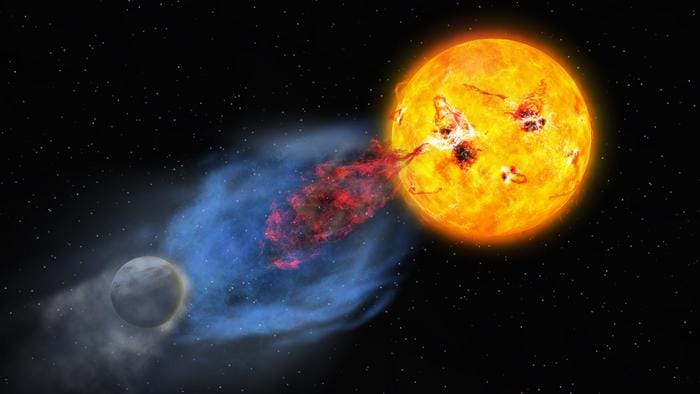
Illustration of a coronal mass ejection from EK Draconis, with blue representing the hotter, faster plasma and red indicating the cooler, slower component. (Credit: NAOJ)
New research suggests that powerful solar storms may have played a critical role in shaping planetary habitability during the early solar system. New multi-wavelength observations of EK Draconis, a young Sun-like star, have revealed coronal mass ejections (CMEs) with both hot and cool plasma components, offering clues to early solar system conditions and planetary habitability. Led by Kyoto University, the study combined Hubble ultraviolet data with ground-based optical spectroscopy to capture a CME ejecting 100,000 K plasma at 300–550 km/s, followed by cooler gas at 70 km/s.
These high-energy events may have chemically altered early planetary atmospheres, contributing to the emergence of life. Research suggests that solar storms on exoplanets could similarly drive prebiotic chemistry by energizing atmospheric particles.
Despatch Out. 👽🛸

Reply